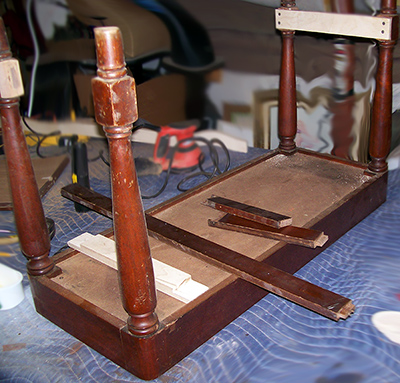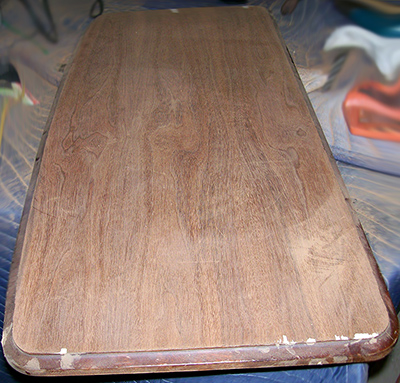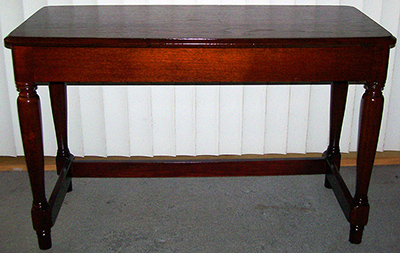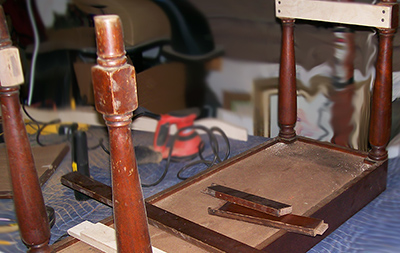Furniture Restoration Process
Step 1 - Establishing Expectations
The first and most critical step in achieving a satisfactory restoration is establishing expectations for how the piece in question will look when the restoration process is complete.
We recognize that not all pieces require a full restoration, so we offer a range or levels of restoration from merely stabilizing the piece, to "touching up" the finish, to completely restoring the piece to its original condition. We can usually stabilize a piece so it will function as intended in a few hours, while a full restoration may take many days over the course of a few weeks.
Generally, the level of restoration determines the cost. Again, we understand that in these days of tight budgets, not all projects will require a full restoration, and so we are quite willing to work within budgetary limits. In order to meet your expectations, we need to know your goals for the piece and any budgetary limitations. If we know we can't meet your goals, we will tell you so.
Step 2 - Evaluation & Estimates
Once we know the project goals, the next step is to evaluate the piece and provide you a restoration plan with an estimate of what it will cost. We must see the piece to evaluate the piece. Oftentimes we can give you a general or "ball park" estimate from photos, but we need to physically inspect the piece in order to give a binding quote. Without examining the entire piece, we cannot give you an informed opinion on the work needed to repair and restore the piece. Having said that, if you provide us photographs, we will give you a "ball park" idea of what the repairs might cost.
You can upload or email pictures to us and we will get back to you with a general estimate of the cost from what we can see in the photographs. This is only a ball park estimate and oftentimes not at all accurate as frequently there is damage to the piece that cannot be viewed from a photograph.
We offer three different ways for arranging a physical examination of the piece. You can deliver the piece to our studio in Hanover, Massachusetts, schedule a site visit by one of our artisans, or we can arrange for a pickup by our White Glove Delivery Service. Once we have the piece, we physically inspect the item for structural integrity. We look for breaks, cracks, splits, weak joints, loose pieces, etc., that if not addressed will further damage the piece or pose a risk to someone using the piece. Chairs are a good example. If a weak leg joint is not repaired, it can lead to a complete failure of the leg, causing the chair to collapse, potentially injuring someone sitting in the chair.
Once the structural problems are identified, we next turn to the aesthetics of the piece, identifying those things we can do to restore the piece to its original beauty. After we have a clear understanding of what is necessary to restore the piece consistent with your goals for the piece, we can prepare a written restoration plan for your approval covering a range of options - everything from simply stabilizing the piece to a complete restoration to its original condition.
Our evaluation process is detailed and takes time, so we must charge for that service, typically $85, which can be applied to the cost of the work if you retain us to perform the restoration. Once you approve the plan and provide us with a deposit equal to half our anticipated fee, we place the piece in line for restoration.
Step 3 - The Antique Furniture Restoration Process
While some repairs can be done on site, most repairs need to be performed in our studio where we have the proper equipment and materials. To give you a better understanding of what's required to repair and restore a piece of furniture, we have set out some of the process steps. The first step in the Restoration Process is to clean dirt and wax build up that may mask damage to the piece or otherwise restrict our ability to make a clean repair.
Typically, the next step is to disassemble the piece or at least those parts that need to be repaired. In many instances, we have to disassemble additional parts so we can properly repair the damage. Despite the extreme care our artisans give to the disassembly process, further challenges develop. For example, old screws break off, requiring that they be drilled out, which may require additional time.
Depending on the work authorized, we may repair the parts or replace the broken parts with new parts. If veneers are badly chipped or missing, we can replace them. Once we have all the parts in good working order, we reassemble the piece. With all the parts back together, we oftentimes have to tune up the piece so that it is square and plumb. This frequently entails shoring up corners and tightening various parts of the piece.
After the piece is fully repaired so that it is in good structural condition, then we turn to the aesthetics of the piece. This is where the artistry truly begins. Our goal is to make the repair disappear. We accomplish this by a combination of color matching, blending, feathering, hand rubbing and sanding to create a finish as close to the original as possible. If the piece is to be "refinished," we first remove the old finish using various stripping methods together with a great deal of hand work, especially when the piece has turnings, carvings or other intricate ornamental elements or mouldings.
Once the old finish is removed, we sand the piece and begin the process of applying the new finish. The standard LeFort finishing process has at least 17 steps including substantial hand sanding and rub out. Applying a finish to a "refinished" piece is actually more complicated than finishing a new piece, because there is not only the challenge of matching the color, but oftentimes the underlying wood has aged, leaving a much wider range of color tones than would be found in a fresh piece of wood. This is an iterative process with many steps required to get that perfect match. Once the finish work is complete, we like to let the piece cure for 24 to 48 hours before the item is ready for delivery back home.
Furniture Delivery Services
We partner with a number of White Glove Delivery services who can pickup and deliver items to the entire continental United States. Our partners have very experienced crews who will carefully remove the piece from your home and wrap it in furniture blankets for transport to our studio. Once the piece is finished, they will deliver the piece back to your home or place it in the location of your choice. Call for our current pickup and delivery charges.













Directions
Visit Our Furniture Site